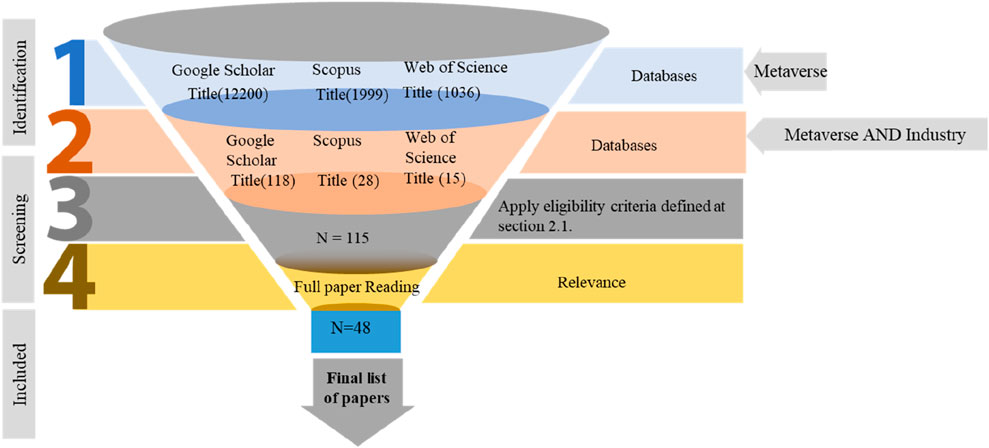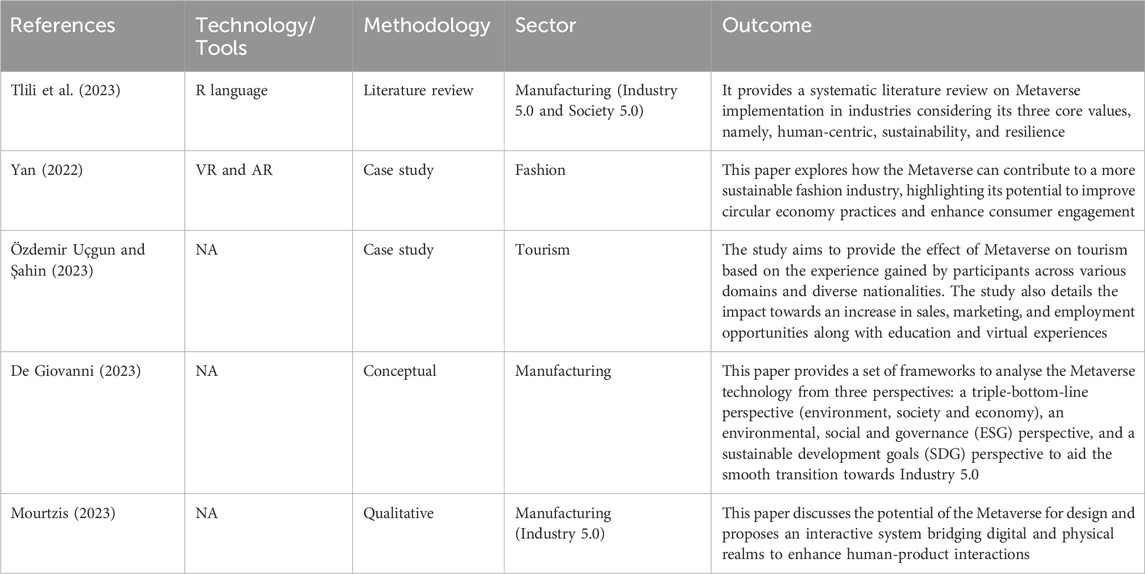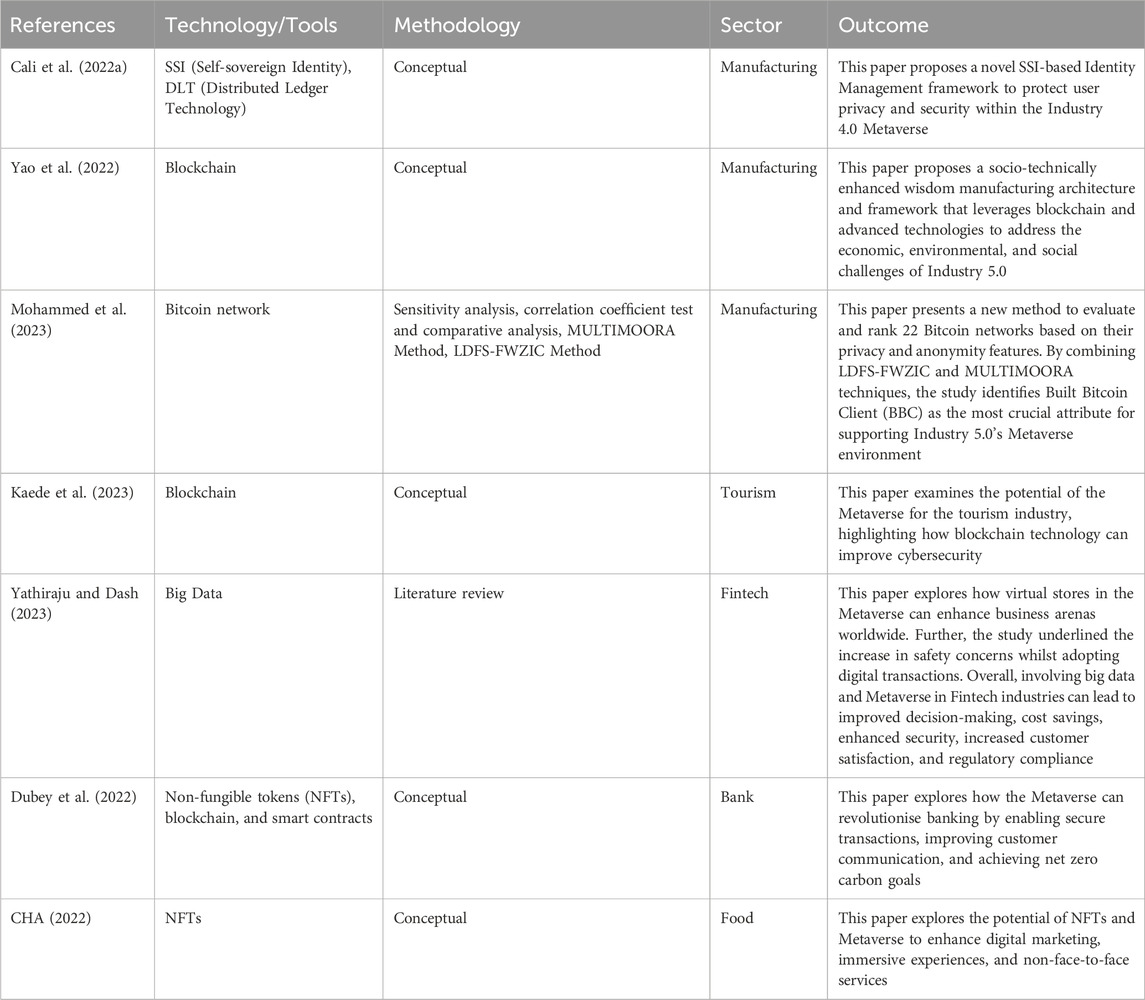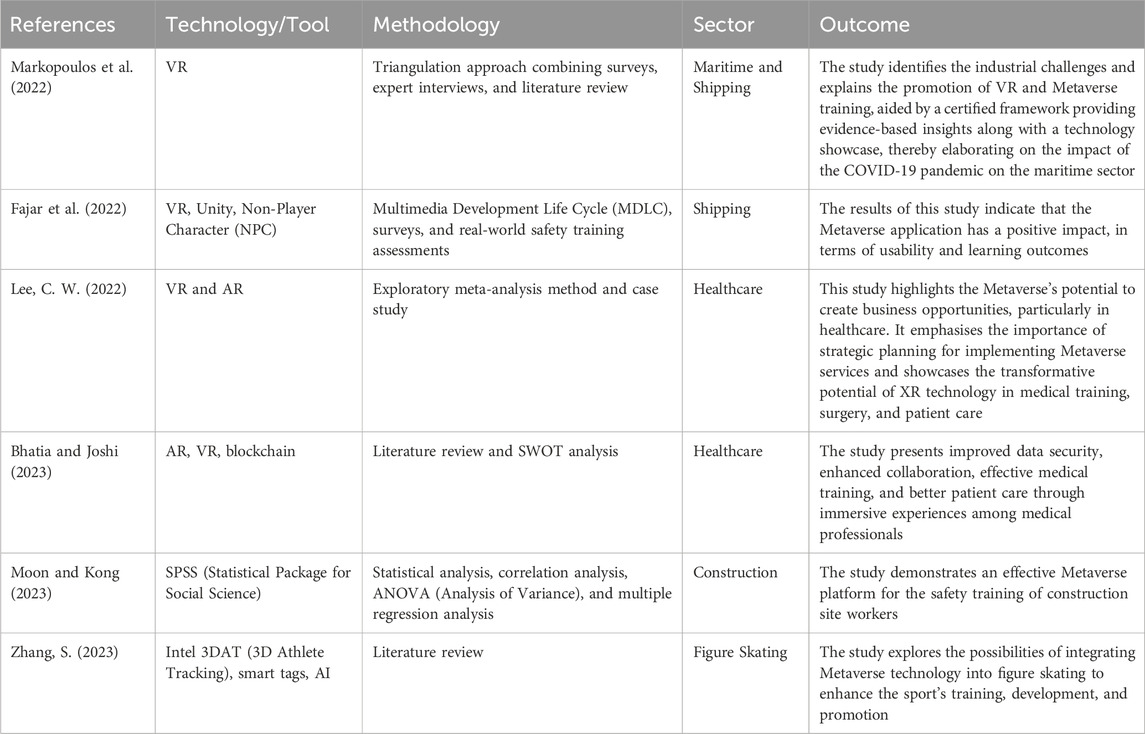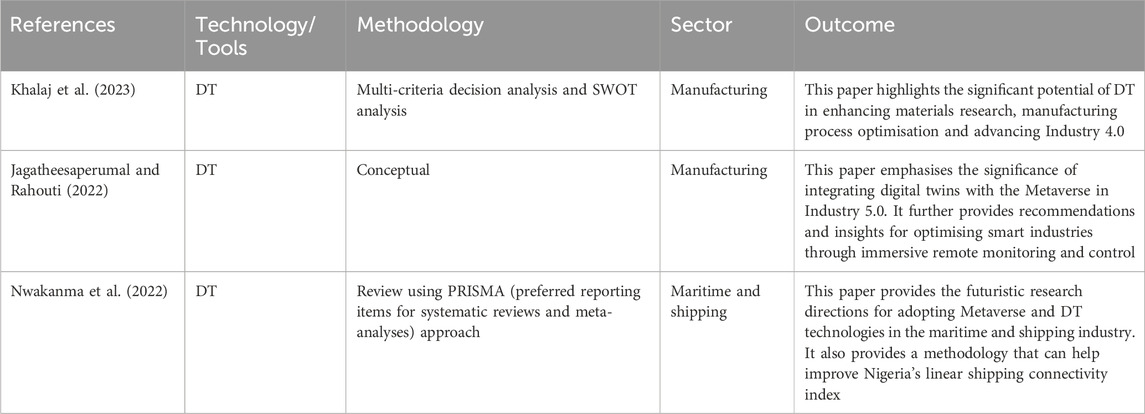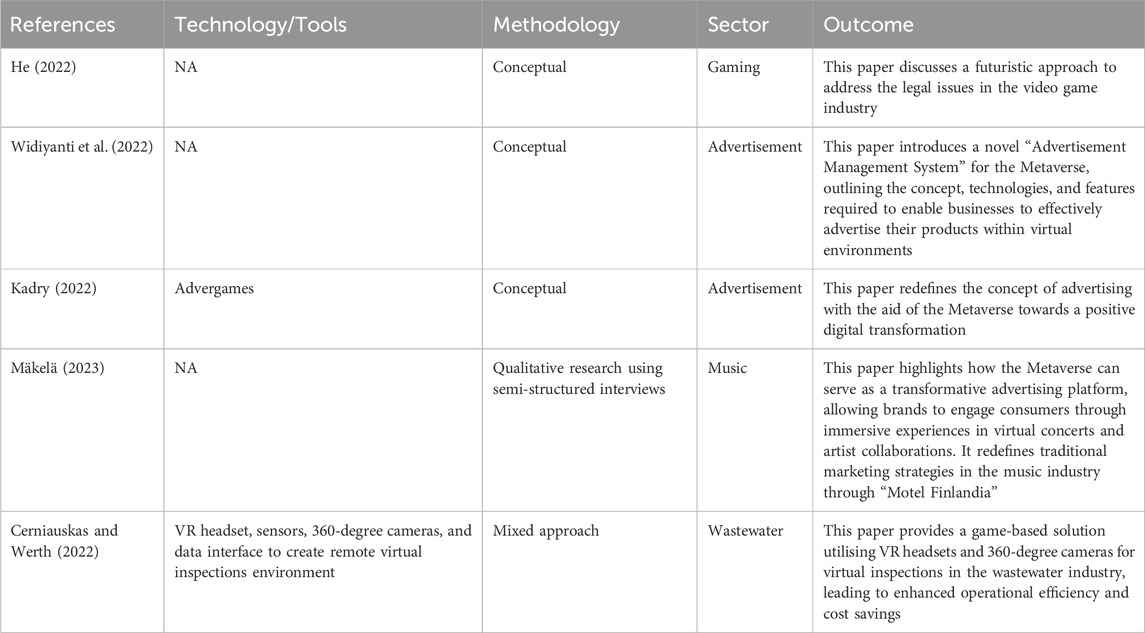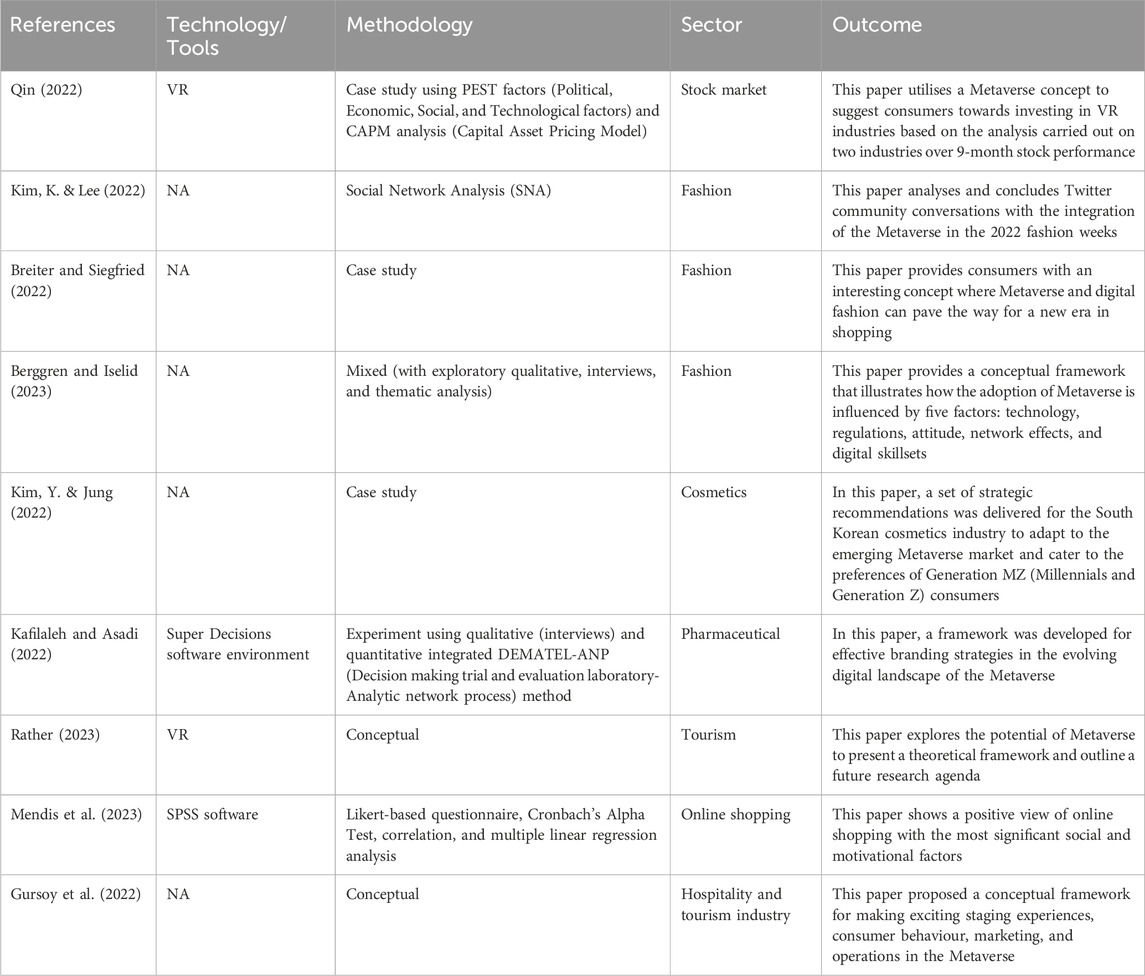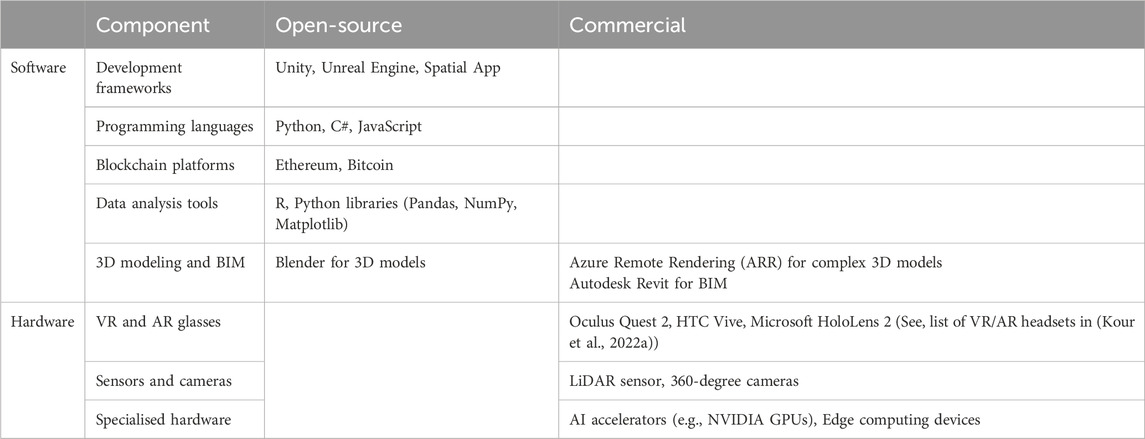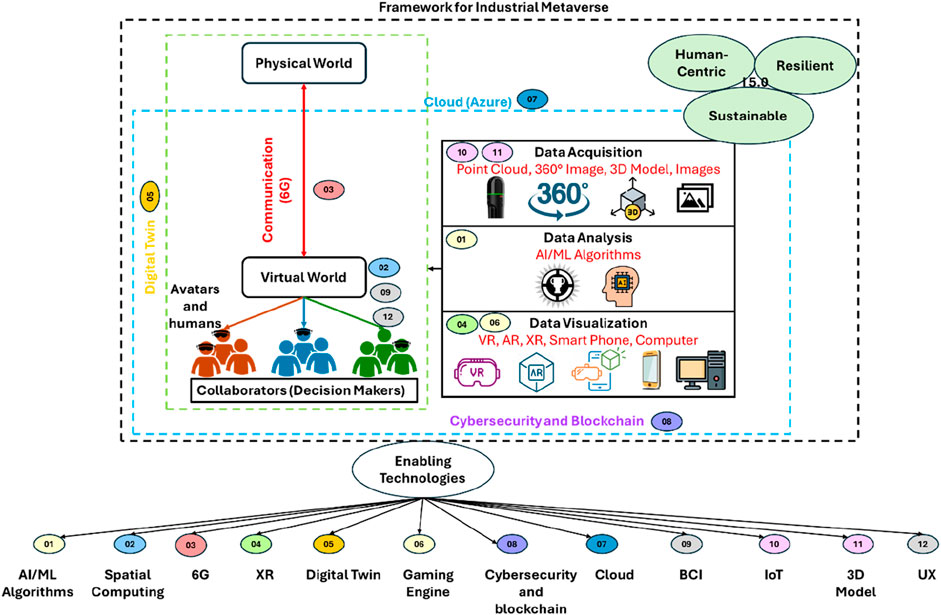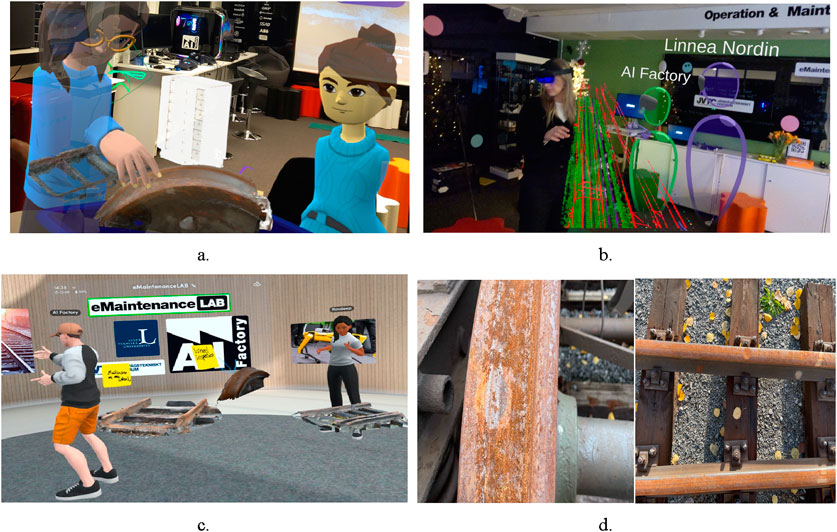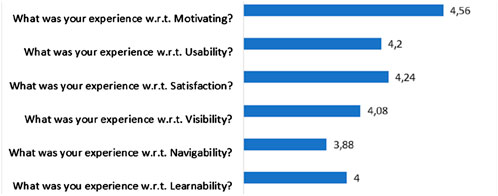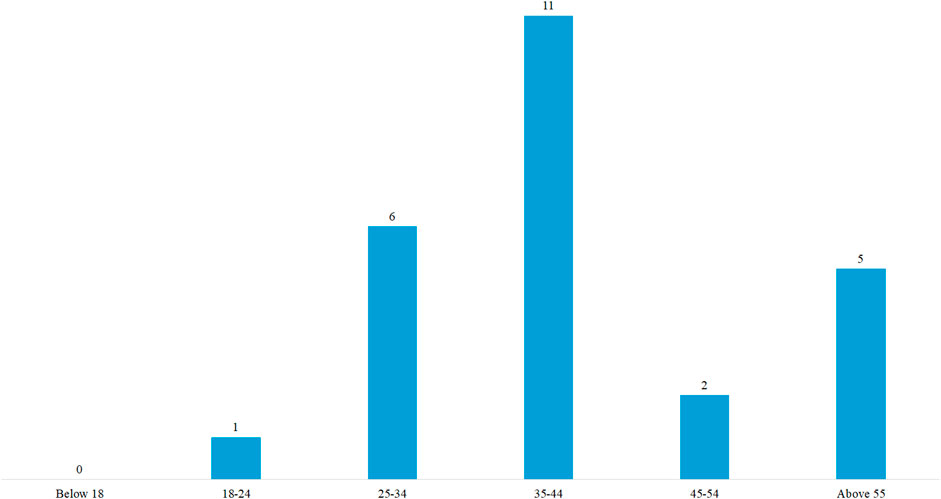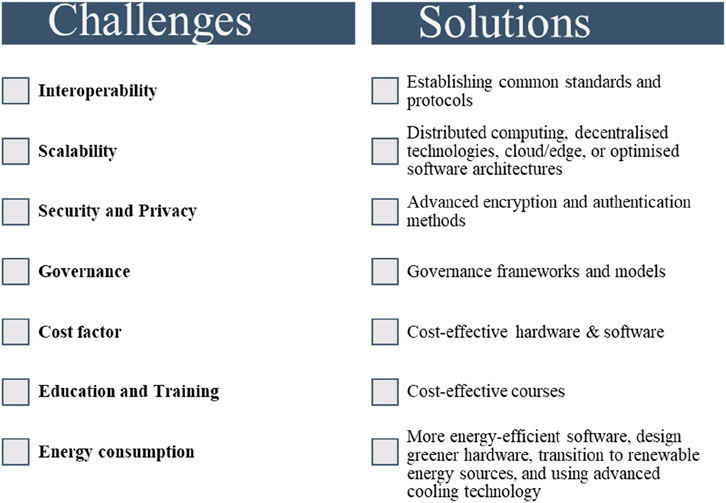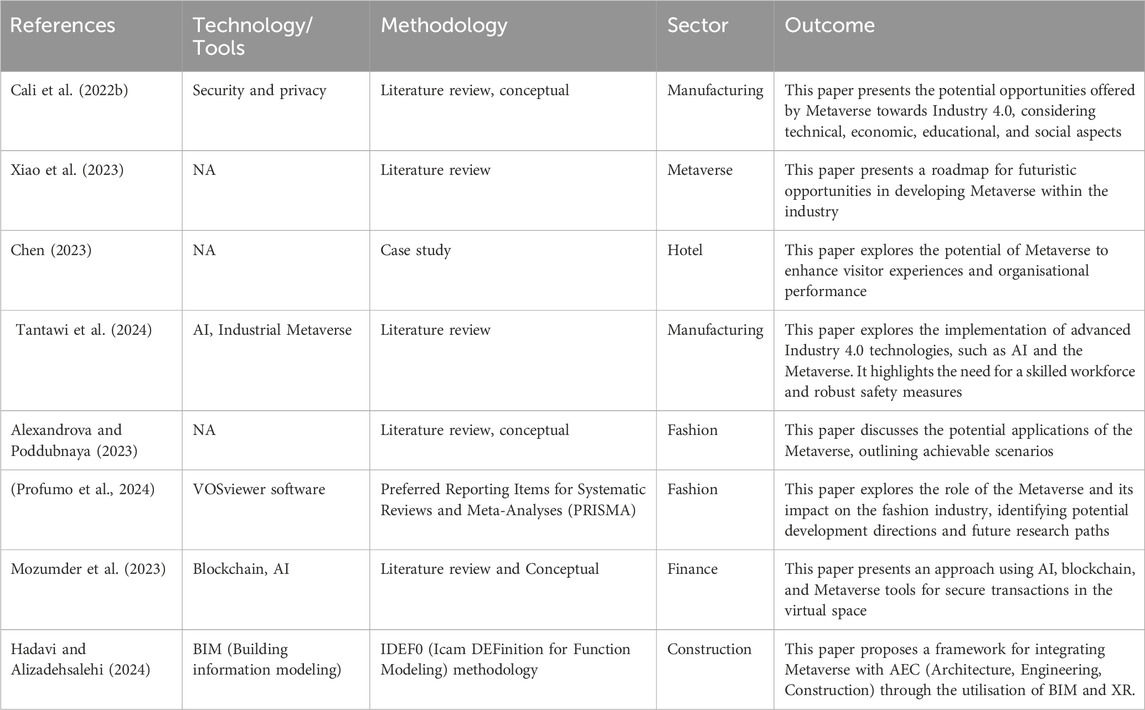- Division of Operation and Maintenance Engineering, Luleå University of Technology, Luleå, Sweden
This paper explores the potential of Metaverse technology in industrial Asset Management (AM). By integrating AI and digital technologies, the Metaverse can enhance Human-System-Interaction (HSI) and optimise AM processes. However, implementing a Metaverse in industrial contexts faces challenges, particularly in visualising physical and virtual assets. This paper conducts a systematic review to address these challenges and identify potential solutions. The findings reveal that while the necessary technologies are available, their widespread adoption in industrial AM is limited. The paper presents a comprehensive overview of research themes related to Metaverse applications in industrial contexts, highlighting the evolving landscape and potential benefits. Ultimately, this research aims to contribute to the advancement of Metaverse technology in industrial AM by providing insights into its development, implementation, and challenges along with an Industrial Metaverse Framework. An example of applying the Metaverse concept in the railway sector has been presented and validated using railway digital assets available within the eMaintenance LAB. The practical implications of this work are expected to result in increased efficiency and effectiveness in the operation and maintenance procedures across various industrial sectors.
1 Introduction
Advanced and innovative technologies are transforming industries globally, potentially enhancing the industrial landscape in areas such as sustainability, resilience, availability, reliability, maintainability, capacity, safety, and security. Transformative digital technologies like Virtual Reality (VR), Augmented Reality (AR), Extended Reality (XR), and Artificial Intelligence (AI) are playing a crucial role in scientific exploration and various industrial domains. These technologies enable immersive experiences and foster collaborative co-creation environments where the digital and physical worlds merge, creating a dynamic collaborative space known as the Metaverse.
The term Metaverse was initially introduced in 1992 by Stephenson in his science fiction novel “Snow Crash” marking the origin of both the term “Metaverse” and its fundamental concept (Stephenson, 2003). Later “virtual world” laid the groundwork for the current understanding of the Metaverse (Animesh et al., 2011; Girvan, 2018; Kohler et al., 2011). To define “virtual world”, (Bell, 2008) has combined the three existing definitions from (Bartle, 2004; Castronova, 2008; Koster, 2004) and emphasises the essential element of people. Thus, the definition of “virtual world” emerges as “a synchronous, persistent network of people, represented as avatars, facilitated by networked computers” (Bell, 2008). This definition highlights the importance of real-time interaction, the continuity of the virtual environment, and the representation of users as avatars within a networked space. The emphasis on people as an essential component highlights the social dynamics and collaborative nature inherent in such virtual environments.
Unlike the recent rise of the term Metaverse, “virtual worlds” such as Second Life (Rymaszewski, 2007) and World of Warcraft (World of Warcraft, 2003) have been central to scholarly discussions about immersive digital environments, social interaction, and economies in virtual spaces for over a decade. The figures from the Scopus database reveal a significant volume of research on virtual worlds published between 2005 and 2025, with a total of 3,474 articles featuring “virtual worlds” in their titles. From 2005 to around 2010, there was a sharp increase in the number of literature, peaking in 2010 with around 350 literature. Following this peak, there is a noticeable decline, though the number of literature remains relatively high through 2013. After that, the number of literature decreases steadily, reaching around 100 by 2025. This trend suggests that research on virtual worlds was highly active in the late 2000s but gradually declined in subsequent years, stabilising at a much lower rate after 2017. This decline can be due to the rise of newer immersive technologies like VR and AR, along with the dominance of social media and interactive online platforms.
Therefore, “virtual worlds” have laid the foundation for Metaverse research, which leverages advanced technologies. Within the Metaverse, users interact with digital assets by creating a multi-user space that merges the physical and virtual world using immersive technologies, namely, VR and AR. This multi-user space consists of virtual assets, which are operated by the AVATARS of real operators who collaborate irrespective of time and space. Thus, in contrast to individual or isolated VR and AR experiences, the Metaverse is a shared, interconnected multi-user space where operators/users interact with each other in real-time.
The primary objective of this research paper is to comprehensively study and explore the development and implementation of a Metaverse within industrial contexts. In this research work, the authors will:
• Identify and examine various research themes related to Metaverse and their relationship to different industry sectors.
• Propose a framework for industrial Metaverse exploiting various enabling technologies in the context of industrial asset management.
• A practical example with the application of the Metaverse concept was added in the present study with a specific focus on the railway sector.
• Identify various opportunities and challenges in the adoption of Metaverse technology within the industrial contexts.
By achieving these objectives, this research aims to contribute valuable insights into the transformative potential of the Metaverse, offering an overview of the Metaverse landscape for its effective development and implementation in industrial contexts.
In this paper, authors have examined the applications of Metaverse technology within industrial contexts. The authors of this paper started with a big picture of the Metaverse and then refined it towards various industrial sectors. Later, they examined the application of Metaverse technology for enhancing asset management (AM) in various industries.
The findings reveal a surge in Metaverse research activity since 2022, with the Manufacturing sector leading the way. Additionally, the current literature findings indicate that this technology is available, but not greatly applied in industrial asset management (Kour et al., 2022b). In recent years, researchers are developing AR interfaces to detect fatigue cracks in real time (Mohammadkhorasani et al., 2023) and visualise product defects directly on physical products (Seeliger et al., 2023). Furthermore, Metaverse technology has been applied in diverse fields, such as Intelligent Railway Passenger Station (IRPS) (Wang et al., 2022), railway asset management (Kour et al., 2022a; 2022b) and digital asset security (Truong et al., 2023). To the best of the authors’ knowledge, there are only a few other publications that comprehensively review the role of the Metaverse in industries, despite its importance. Therefore, a comprehensive review is needed to identify current trends, research gaps, and emerging topics for future research. This paper aims to bridge the knowledge gap by reviewing the Metaverse in industrial contexts, examining various themes and their relationship to Industry 4.0 and Industry 5.0. The paper aims to answer the following research questions:
RQ1 – What are the key technologies enabling the Metaverse in industrial contexts?
RQ2 – How has the Metaverse been applied across different industrial domains?
RQ3 – What are the challenges and limitations associated with the implementation of Metaverse in industrial scenarios?
RQ4 – What are the future trends and how Metaverse will aid in the shift towards Industry 5.0?
The automation and interconnectivity that defined Industry 4.0 (Munirathinam, 2020), lays the groundwork for the evolution of a new industrial era, Industry 5.0 or the Industrial Metaverse. In this new era, physical and virtual worlds converge, leading to a more human-centred and collaborative approach. Some systematic reviews highlighted early-stage Metaverse adoption in industries, emphasising its potential applications, particularly within the human-centric aspect of Industry 5.0 (Mourtzis et al., 2022; Tlili et al., 2023). On 4 January 2021, the European Commission shared a document titled “Industry 5.0: Towards a Sustainable, Human-centric, and Resilient European Industry” encouraging industries to re-think their positions and roles in society (Breque et al., 2021). The following text briefly explains the key components of Industrial Metaverse in the context of Industry 5.0, with a particular focus on the enabling technologies facilitating digital transitions. These technologies include VR, AR, XR, AI, Industrial Internet of Things (IIoT), big data, cloud/edge/Fog computing, blockchains, digital twins, BCI, and so on.
• Extended Reality: Extended reality (XR) refers to all real and virtual environments combined, where human and machine interaction occurs through interactions generated by computer technology and hardware. XR technologies consist of VR and AR (Doolani et al., 2020).
• Security: Metaverse provides many benefits but also suffers from security/privacy risks, such as personal information leakage, eavesdropping, unauthorised access, phishing, data injection, broken authentication, data theft, and so on (Huang et al., 2023).
• Blockchain: Blockchain is a decentralised and immutable distributed ledger that revolutionises human-system interactions through trust and transparency (Narayanan et al., 2016).
• Smart Contracts: Smart contracts, in the context of blockchain, are self-executing digital agreements that facilitate automated, trust-based interactions among human systems (Narayanan et al., 2016).
• AI: AI can help in human-computer interactions within the Metaverse environment by including 3D modelling, computer vision, speech-to-text, Natural Language Processing (NLP), and others (Prabadevi et al., 2023).
• Gamification: Gamification in the Metaverse is the application of game design principles, mechanics, and incentives to enhance user engagement, participation, experiences, and memorisation within virtual environments (Afacan, 2023).
• UX: User Experience (UX) in the Metaverse refers to the overall quality of interaction and engagement that users have within immersive virtual environments, encompassing elements such as interface design, social interaction, and spatial navigation (Delgado, 2022; Mystakidis, 2022).
• Web 4.0: Web 4.0, often referred to as the symbiotic web and recognised as the next-generation of the internet, aims to integrate AI, IoT, blockchain, virtual worlds, and extended reality for seamless human-machine interaction and enhanced website performance (Zhou et al., 2023).
• 6G: The sixth generation or 6G is the recent standard of wireless communication in the telecommunication industry which is still being researched. While 5G facilitates a variety of services ranging from mobile broadband to Industry 4.0, Metaverse, IoT, and automated driving (Andrews et al., 2014), 6G is believed to satisfy the future demands for information and communications technology (ICT) (Jiang et al., 2021).
• Cloud/Edge/Fog computing: Edge and cloud computing accelerates data storage, communication, enhances network security, enables efficient synchronisation between the physical world and the Metaverse (Prabadevi et al., 2023). To further reduce the latency, fog computing can provide computation and storage services connected via edge devices (Xu et al., 2022).
• 3D modelling: 3D modelling in the Metaverse enables the creation of 3D avatars, spaces, and virtual environments, facilitating user interactions and operations while supporting human system interactions through advanced visualisations (Prabadevi et al., 2023).
• IoT and IIoT: The Internet of Things (IoT) refers to the technology that facilitates a network connecting intelligent assets with the Internet through wired or wireless networks (Madakam et al., 2015) and its industrial applications are known as the Industrial Internet of Things or IIoT (Agenda, 2015).
• Brain-Computer Interface: Brain-Computer Interface (BCI) is a system that enables a connection through electrical signal transmission between the brain and the computer, often used to carry out tasks or control an external device (Lei, 2023).
• Spatial Computing: Spatial computing refers to the modelling and digitisation of the computing device’s environment such that the device has a spatial context concerning its surroundings (Delmerico et al., 2022).
The paper is structured as follows: Section 2, outlines the methods used to conduct this review process. Sections 3 present the overall trends in research, including publication years, literature, technologies/tools, and methods. Sections 4, 5 describe an Industrial Metaverse framework with a specific focus on its application in the railway sector. Section 6 explores the potential opportunities and challenges of the Metaverse. Section 7 provides a list of observations from the reviewed literature. Finally, Section 8 provides the conclusions.
2 Research methodology
The research methodology employed in this paper has followed PRISMA (Preferred Reporting Items for Systematic Reviews and Meta Analyses) methodology (Moher et al., 2009) for transparent and unbiased systematic review (See, Figure 1). It encompasses the following components: Eligibility Criteria, Information Sources, Search Process, Study Selection, and Data Collection & Analysis of Results.
2.1 Eligibility criteria
Articles considered for this review must meet the following criteria:
• Publication from January 2021 and March 2024.
• Availability of the full-text manuscript on Google Scholar, Scopus, Web of Science.
• Publication in a peer-reviewed or scholarly journal, conference, or thesis.
• Availability in the English language.
2.2 Information sources
To extract relevant literature pertaining to the Metaverse’s applications within industrial settings, the authors of this paper explored three specific databases: Google Scholar, Scopus, and Web of Science.
2.3 Search strategy
To recognise the initial scope of Metaverse applications in industrial contexts, the authors of this paper have conducted a web-based search (See, Figure 1). They explored articles related to the Metaverse across various industries. The study used popular databases, including Web of Science, Scopus, and Google Scholar. The two search queries (SQ) used were:
SQ1: “Metaverse”
SQ2: “Metaverse AND Industry”
SQ1 has been used to know Metaverse research at a bigger level (See, Section 3.1). SQ2 has been used to know Metaverse research in Industrial contexts (See, Section 3.2). All the literature using SQ2 was merged to delete duplicate entries and authors were left with 48 papers to carry out the review.
2.4 Study selection
This review paper has focused on the study of Metaverse applications within industrial contexts. From an initial pool of 115 papers, 48 were selected based on their relevance to industrial contexts. These 48 papers were then analysed in detail, with a specific focus on technologies, methodologies, the targeted industry, and the outcomes within each industrial setting.
2.5 Data collection and analysis of results
A series of consensus meetings was conducted to collect and analyse the results. After applying the eligibility criteria (Section 2.1) and initial screening, 115 articles were identified. Three researchers independently read the full text of these articles to either select or reject it based on its relevance. Ultimately, 48 articles were selected for inclusion in the final analysis.
To ensure the robustness of this systematic review, several validity threats were addressed, including selection bias, mitigated by clear eligibility criteria and the use of multiple reputable databases (Google Scholar, Scopus, and Web of Science). Limitations, such as restricting studies to English and a specific timeframe, were acknowledged as potential exclusions of relevant works. Information bias, stemming from limited search queries, was minimised through consensus meetings among researchers, with three independently analysing and resolving discrepancies in selected papers. Adhering to PRISMA method, the review assessed 48 studies for quality and relevance, focusing on Metaverse applications in industrial settings. Most of the selected studies were published in high-quality peer-reviewed journals or conferences indexed in databases such as Scopus and Web of Science, ensuring credibility and relevance to the field.
3 Results
3.1 Trends in Metaverse research: the big picture
There are 2,990 documents related to “Metaverse” in the title of literature on Scopus, 1,559 on Web of Science, and a significant 12,100 on Google Scholar, with 30.8% in the field of computer science, 17.2% in engineering, 11.8% in social sciences, and the remaining percentage covering various other subjects. To refine the research focused on Metaverse in industrial contexts the authors have come up with the trends presented in Sections 3.2–3.3.
The authors of this paper have developed a tool using PowerBI from Microsoft (Microsoft, 2024) for visualising the results (See Figures 2–4). Figure 2 shows statistics of “Metaverse” literature related to its timeline, type, and paper keywords. Scopus search result indicates that 11% of articles were published till March 2024, with 62% published in 2023 and 24% in 2022. This trend shows research in the Metaverse has recently gained attention in the academic communities. Most of the output from Metaverse research is distributed between academic journals (45%), conferences (32%), book chapters (10%), and others. An analysis of the keywords used in these papers highlights terms like virtual reality, augmented reality, digital, learning, education, blockchain, digital twins, AI, human, social aspects, healthcare, and more.

Figure 2. Statistics of literature based on SQ1; Top: “Timeline of Literature by Year,” Bottom Left: “Literature Type,” and Bottom Right: “Research Area”.
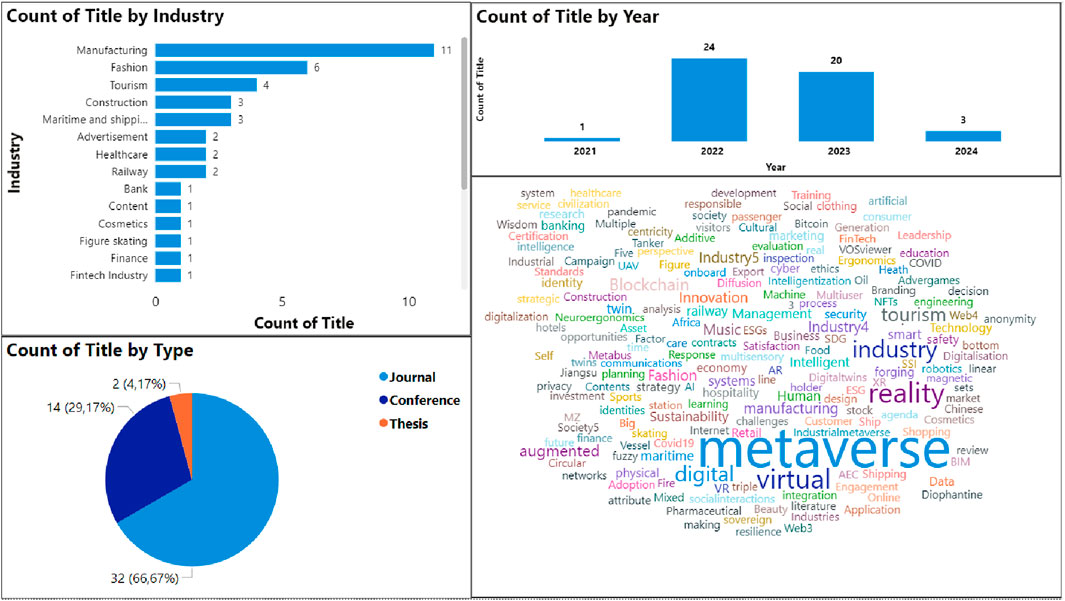
Figure 3. Statistics of reviewed literature based on SQ2; Top Left: “specific industries involved”, Top Right: “Timeline of Literature by Year”, Bottom Left: “Literature Type”, and Bottom Right: “Research Area”.
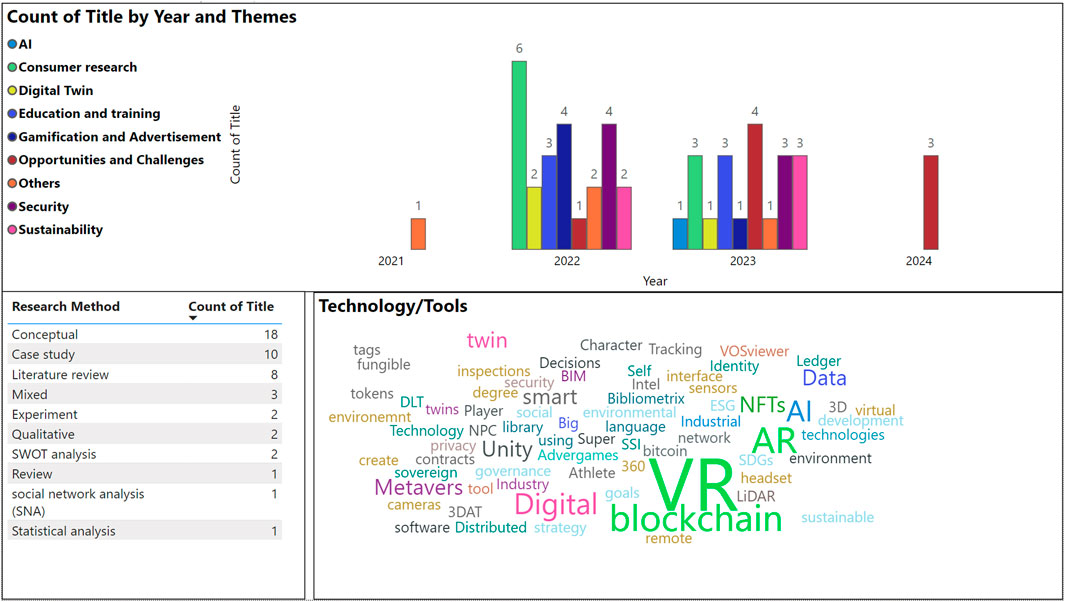
Figure 4. Statistics of reviewed literature based on SQ2; Top: “Count of literature by different themes distributed over timeline from 2021 to March 2024”, Bottom Left: “count of literature based on research methods used”, and Bottom Right: “Word cloud of technologies featured in the literature”.
3.2 Trends in Metaverse research in industrial contexts: the refined picture
By analysing publications in recent years, we can identify how research themes on the Metaverse in industrial contexts have evolved. The literature search focused on the most relevant publications published between January 2021 and March 2024. This trend suggests a surge in Metaverse research activity since 2022, with the manufacturing sector leading the way (23%). Other prominent industries include fashion (13%), tourism (8%), and construction and shipping (6%).
Figure 3 analyses the frequency, type, and research area of Metaverse applications in industry. Our database search for SQ2: “Metaverse AND Industry” in the title identified that 2% of articles were published in 2021, followed by a significant rise in 2022 (50%), continued growth in 2023 (42%), and 6% published by March 2024. Interestingly, the research outputs are distributed across academic journals (67%), conferences (29%), and theses (4%). An analysis of keywords used in these publications reveals a focus on terms like Metaverse, augmented reality (AR), blockchain, and specific industries like manufacturing and tourism.
3.3 Comprehensive review results by research themes
This section analyses comprehensive review results categorised by research themes. Figure 4 depicts the distribution of papers by year and theme, along with the research methods employed. The review encompasses 48 most relevant papers published between January 2021 and March 2024.
The research themes were identified by the review team through a comprehensive examination of the title and full texts of the selected papers. To ensure consistency, the team utilised a shared platform to record all observations, including author details, utilised technologies, relevant industries, and paper outcomes (as presented in Tables 1–6).
Consumer research and security emerged as the dominant themes within the reviewed literature. As shown in Figure 4, out of 48 papers categorised across nine themes, consumer research (17%), opportunities and challenges (17%), security (15%), gamification (13%), education and training (10%) and sustainability (10%) constituted the most prominent areas of focus.
Beyond the Metaverse, a keyword analysis of the reviewed papers revealed a focus on technologies such as VR, AR, blockchain, NFTs, smart contracts, and digital twins. It is noteworthy that the qualitative research method was prominent in the reviewed papers, with conceptual work and case studies being the most common approaches.
The more refined results and discussions related to these nine themes are presented in Sections 3.3.1–3.3.8. Out of these themes “opportunities and challenges” theme is defined in Section 5.
3.3.1 Sustainability and Metaverse
The Metaverse is closely linked to sustainability, as it has the potential to impact environmental, economic, and social aspects worldwide, making sustainability a central concern. The Metaverse offers more than just immersive experiences. It can also contribute to a more sustainable world by promoting resource efficiency, reduced carbon footprints, minimised waste, and cost savings. For instance, the fashion industry can leverage the Metaverse to allow virtual try-ons of branded products, significantly reducing costs and energy consumption associated with physical try-ons. Table 1 lists industries that have adopted Metaverse technology with a focus on sustainability. For instance, Yan (2022) has explored digital fashion in the Metaverse, highlighting its positive impacts on sustainability, consumer experiences, and the environment. In another study, researchers explored how the Metaverse is changing tourism, focusing on its positive effects on users, tourism service providers, and sustainability through virtual experiences (Özdemir Uçgun and Şahin, 2023). Within the manufacturing industry, authors of (De Giovanni, 2023; Tlili et al., 2023) have analysed the sustainability of the Metaverse technology and called for global collaboration to responsibly implement it. In addition, the author in (Mourtzis, 2023) has developed a human-centric framework to improve product design for the Metaverse, making it easier to move between digital and real worlds.
3.3.2 Security and Metaverse
Metaverse involves a decentralised system to connect many users to share data and, therefore, it is essential to monitor the contents and human behaviour. Within manufacturing industries, researchers have discussed the integration of cybersecurity in the Metaverse through three different concepts:
(i) self-sovereign identity (SSI) within Industry 4.0, highlighting the advantages of decentralised identity management and addressing privacy and security concerns (Cali et al., 2022a),
(ii) integration of blockchain technology into a decentralised Socio-Cyber-Physical Production System (SCPPS) to facilitate human-centric and innovative manufacturing that foresees Industry 5.0 (Yao et al., 2022), and
(iii) using the Linear Diophantine Fuzzy Set-Fuzzy Weighted Zero Inconsistency (LDFS-FWZIC) and Multi-Objective Optimisation based on a Ratio Analysis plus the full MULTIplicative form (MULTIMOORA) methods to rank 22 bitcoin networks for supporting Industry 5.0’s Metaverse environment, emphasising privacy and anonymity attributes as crucial (Mohammed et al., 2023).
Post-pandemic (Harapan et al., 2020) research explores the Metaverse’s potential to transform tourism, examining its impact, current understanding, and secure experiences via blockchain (Kaede et al., 2023). While Big Data and the Metaverse hold immense potential for the Fintech industry, enhanced security solutions are crucial to safeguard financial data and transactions in this immersive environment (Yathiraju and Dash, 2023). Additionally, in banking, the adoption of the Metaverse can support the circular economy, improve operations, and reduce waste by enabling secure and transparent transactions through blockchain and web 3.0 technologies (Dubey et al., 2022). In the food industry, researchers have suggested that NFTs and the Metaverse offer opportunities to enhance marketing, engagement, and digital services (CHA, 2022). The concept of security in the Metaverse applied in various industries is detailed in Table 2.
3.3.3 Education and training using Metaverse technology
The Metaverse enhances training and education by creating immersive, interactive learning environments that involve learners and offer realistic simulations for effective skill development. Within the maritime and shipping industry, researchers have investigated how VR and the Metaverse can improve maritime training and certification, proposing a new VR-based certification framework (Markopoulos et al., 2022). Additionally, they focused on how the Metaverse and VR technology can be used to enhance safety training, with a case study of a government-owned corporation (Fajar et al., 2022). Within healthcare, researchers have explored the need for systematic strategic planning to leverage the potential of Metaverse services for effective medical training, and better patient care through immersive experiences (Lee, 2022). Further, researchers have explored using Metaverse technologies like blockchain, VR, and AR to improve healthcare by enhancing data security, collaboration, training, and patient care (Bhatia and Joshi, 2023). The concept of Metaverse was also widely adopted in the construction industry wherein the importance of fire safety education was introduced to construction workers through virtual training thereby enhancing safety awareness among them (Moon and Kong, 2023). Further, an initiative to apply Metaverse technology in association with computer vision and data analytics has been proposed by research experts to enhance training in the figure skating industry by creating immersive simulations that improve athletes’ performance and technique (Zhang, S., 2023). A detailed discussion of the education and training concepts utilising the Metaverse is presented in Table 3.
3.3.4 Digital twin and Metaverse
The industrial Metaverse takes Digital Twins (DT) to the next level by facilitating various stakeholders to collaborate in a virtual space and run operations in a virtual environment. Within the manufacturing industry, researchers have emphasised the significance of integrating DT with the Metaverse in advancing Industry 4.0 through material research optimisation, enhancing production efficiency and initiating smart manufacturing (Khalaj et al., 2023). Additionally, DT technology, when combined with the immersive capabilities of the Metaverse, has the potential to revolutionise how smart industries operate in the Industry 5.0 era (Jagatheesaperumal and Rahouti, 2022). DT-powered Metaverse can optimise production processes by providing real-time data, insights, and collaborative tools for remote monitoring, control, worker training, and efficiency. In the maritime and shipping industry, researchers have discussed the prospect and industry issues of Metaverse and DT adoption to improve Nigeria’s linear shipping connectivity index (Nwakanma et al., 2022). A varied landscape of applications of the Metaverse and DT has been showcased in Table 4.
3.3.5 Gamification and advertisement using Metaverse technology
Gamification within the Metaverse involves incorporating in-game elements and mechanics to enhance user experience and immersion within interconnected virtual environments. Researchers have emphasised the need to carefully watch game developments and assess the potential impact of legislative moves and legal decisions. A suggestion was made to the gaming industry towards the establishment of a strict code of practice for gamer contributions and that the legal rules should be constantly updated to come up with better solutions (He, 2022). Within the advertisement industry, researchers have recommended the implementation of an Advertisement Management System in the Metaverse to facilitate product promotion within a virtual environment (Widiyanti et al., 2022) along with its impact on the industry (Kadry, 2022). However, the influence and adoption of the Metaverse and its associated tools are still in their infant stages of development in the music industry (Mäkelä, 2023) and wastewater management sectors (Cerniauskas and Werth, 2022). An overview of the aforementioned literature is presented in Table 5.
3.3.6 Consumer research and Metaverse
Consumer research in the Metaverse investigates user behaviours, preferences, and experiences in the digitally interconnected world that allows companies to tailor marketing campaigns and product offerings within the virtual environment. The possible industrial applications of Metaverse concepts in consumer research include the stock market, fashion, tourism, cosmetics, pharmaceuticals and online shopping. A recent study related to the stock market utilised the Metaverse concept to suggest that users invest in the VR industry. Political, economic, social and technological (PEST) factors were considered in an investment environment to analyse the performance of the stock trend of two sectors for 9 months using a Capital Asset Pricing Model (CAPM) (Qin, 2022). In a different scenario, the integration of Metaverse concepts into the fashion industry has been discussed among Twitter communities towards implementation during 2022 fashion weeks (Kim and Lee, 2022). Further discussions were introduced focusing on consumer attitudes and expectations on the impact of Metaverse (Breiter and Siegfried, 2022) and the factors that can influence Metaverse adoption inside the fashion industry (Berggren and Iselid, 2023). The integration and impacts of a Metaverse in cosmetics (Kim and Jung, 2022), pharmaceuticals (Kafilaleh and Asadi, 2022), tourism (Rather, 2023) and online shopping platforms (Mendis et al., 2023) are presented in Table 6.
3.3.7 AI and Metaverse
AI plays an important role in the Metaverse, enhancing various aspects like content creation, chatbots, speech recognition, machine vision, natural language processing, 3D modelling, and education, promising significant potential for collaboration as the Metaverse evolves (Pooyandeh et al., 2022). Researchers have proposed an approach using qualitative methods to combine human systems integration (HSI), additive manufacturing, and neuroergonomics to enhance the efficiency and safety of manufacturing processes (Singh, 2023). An emphasis was made on the importance of considering human factors and utilising machine learning techniques in the design whilst implementing Industry 6.0 systems (Singh, 2023). Researchers have proposed a human-centric model for sustainable asset management in the railway industry using AI, VR, and MR technologies (Kour et al., 2022a).
3.3.8 Others
Other researchers have explored the application of the Metaverse in construction and future architecture (Zhang, R. et al., 2023), railways (Kour et al., 2022b; Wang et al., 2022), while also looking at its history, current state, business models (Park, 2021).
3.4 Summary of software/hardware used in Metaverse applications
This section shows the summary of hardware and software used in the Metaverse applications based on the reviewed literature (See, Table 7). Key technologies include virtual and augmented reality (VR/AR) for immersive experiences, blockchain for security and transparency, big data for informed decision-making, digital twins for virtual representations, and Industry 4.0 for optimised manufacturing. Specific tools and platforms mentioned encompass Super Decisions software, VR headsets, sensors, 360-degree cameras, non-fungible tokens (NFTs), smart contracts, the R language with Bibliometrix, Intel 3DAT, smart tags, AI, self-sovereign identity (SSI), distributed ledger technology (DLT), building information modeling (BIM), and the VOSviewer tool. Additionally, the integration of VR, AR, Unity, and LiDAR is highlighted for precise interactions within the Metaverse.
4 Framework for industrial Metaverse
A framework for the industrial Metaverse, as illustrated in Figure 5 has been proposed, leveraging enabling technologies defined in Section 1. The core of this framework represents the physical world, representing the real-world environment where industrial operations take place. This framework focuses on creating a human-centric, resilient, and sustainable collaborative environment based on Industry 5.0 that bridges physical and virtual worlds. The human-centric approach emphasises the importance of human interaction and involvement in this Metaverse environment. Resilience is essential to ensure that the Metaverse can adapt to changing conditions and remain operational even in the case of disruptions. Metaverse’s sustainability is a key consideration, defined in Section 3.3.1. A digital twin is the core of the framework that can create virtual representations of digital assets.
Data acquisition within the framework plays an important role, involving the collection of data from the physical world using various sensors and devices. This data is then analysed using AI/ML algorithms to extract valuable insights and information. The results of this analysis are presented through data visualisation techniques, utilising technologies such as VR, AR, XR, smartphones, and computers. Collaborators or decision-makers within this framework are the individuals who interact and collaborate within the industrial Metaverse to facilitate effective decision-making. These decision-makers can be humans interacting with the avatars of other humans (See Figure 5) or avatars of robots in future. The proposed framework is enabled by a wide range of enabling technologies, including AI/ML algorithms, spatial computing, 6G, XR, digital twins, gaming engines, cybersecurity, cloud computing, BCI, IoT, 3D modeling, and UX design. These technologies work together to create a collaborative and immersive Metaverse experience.
The connections between the different components of the framework are essential for its effective functioning. Therefore, data acquisition feeds into data analysis and visualisation, allowing for the extraction of meaningful contextual information. Collaborators interact within the virtual world, leveraging the capabilities of the industrial Metaverse to support their decision-making processes. The enabling technologies provide the foundation for the Metaverse’s operation, supporting all other components. Thus, the proposed framework demonstrates how the integration of various technologies and a human-centric approach can create a powerful and valuable tool for industries. By bridging the physical and virtual worlds, the industrial Metaverse can enhance efficiency, improve decision-making, and drive innovation. This framework has been explained by providing an example of its implementation in the railway industry in Section 5.
5 Application of Metaverse in the railway sector
The comprehensive literature review reveals that the application of Metaverse technology in industries remains in its early stages and necessitates further development. This paper contributes by exemplifying its application within the Swedish railway sector. The Swedish Transport Administration (Trafikverket) manages Sweden’s complex railway system, encompassing infrastructure, rolling stock, communication systems, and energy grids. Strict maintenance timetables are in place, yet physical asset inspections like those of tracks, wheels, and switches can be challenging in remote locations, during heavy snowfall, or under pandemic restrictions. Metaverse technology offers a promising solution by facilitating remote inspections through a shared and collaborative platform. This Metaverse is sustainable with its potential to save time, cost, and energy while reducing carbon footprints.
The Metaverse within the railway sector allows maintenance engineers, and other stakeholders from various locations to collaborate in a shared virtual space where they can view the inspection data or the condition of railway assets (Figure 6). This technology is expected to enhance the inspection process and facilitate decision-making in railway operation and maintenance. By eliminating distance barriers, the Metaverse enables collaborators to discuss railway assets and make informed decisions for future maintenance by bringing their assets to their desk or laboratory.
Figure 6 depicts a Metaverse environment where AVATARS of various operators visualise and discuss wear on a railway wheel and rail. Figure 6A shows Metaverse with two AVATARS of operators from different locations inspecting railway wheel using AR technology. Figure 6B shows Metaverse with three operators (1 person, two avatars in green and purple colour) collaborating to visualise railway track and catenary model at the same time irrespective of their locations using Azure Remote Rendering (ARR). ARR helps to render highly complex 3D models in real time on devices such as HoloLens 2 (See, Figure 6B). Figure 6C shows the same operators within the Metaverse environment, now fully immersed in a virtual space. Here, they can closely inspect the railway wheel and rail surface (Figure 6D) using VR technology. Notably, the Metaverse can accommodate a combination of devices for remote inspection, including VR headsets, AR glasses, smartphones, and even traditional computers.
To evaluate the effectiveness of Metaverse for Railway AM, seminars and workshops have been conducted with railway stakeholders. These sessions highlighted the technology’s ability to improve the inspection process and support effective decision-making. An approach defined in the previous research work (Kour et al., 2022a) for evaluating the developed solution has been employed. The same set of parameters, i.e., learnability, navigability, visibility, satisfaction, usability, and motivation (Kour et al., 2022a) have been used in the questionnaire. The results depicted in Figure 7 show evaluation results for the above-mentioned parameters.
Many users rated motivation, satisfaction, visibility, and usability higher, possibly due to a strong interest in using these technologies for enhancing the decision-making process in operation and maintenance. Learnability and navigability were rated lower, likely due to the novel interface of the HoloLens2 device, involving gestures and haptic interactions rather than traditional keyboard, mouse, and joystick methods, causing navigational challenges for users unfamiliar with haptic interfaces.
The age distribution within the population is presented in Figure 8, with seven females and 18 males. Most of the sample falls in the age group of 35–44 years, with fewer participants in the 18–24 age group. This group of participants includes railway stakeholders, academic researchers, and students. The railway stakeholders consist of individuals such as project managers, investigation coordinators, track technicians, track engineer trainees, fleet controllers, and IT business developers. The remaining end-users primarily have backgrounds in operations and maintenance. Out of 25 participants in the same environment, three participants (2 females and one male) experienced nausea (motion sickness) while moving within the VR environment.
Furthermore, the Metaverse holds educational value for researchers and students. A team of students from the railway and construction domain have already had hands-on experience with the Metaverse within the eMaintenance LAB (AIF, 2023), and they expressed great fascination and excitement about these technologies. These technologies can enhance students’ learning capabilities by providing an immersive environment where they can visualise and interact with digital assets of interest without going into the field.
6 Metaverse challenges, opportunities and research directions
The ongoing digital transformation presents both challenges and opportunities for applying the concept of Metaverse to transform various industries. These challenges and opportunities are presented in the following sections.
6.1 Metaverse challenges
While the Metaverse offers a lot of opportunities, there are also significant challenges to consider. A key challenge lies in ensuring interoperability between different Metaverses from different companies, particularly when linking virtual and real-world environments (Cali et al., 2022b). Other challenges include data security, privacy, decentralisation, skilled workforce development, resource management, communication difficulties, and high implementation costs (Cali et al., 2022b; Chen, 2023; Tantawi et al., 2024). Figure 9 presents the key challenges in Metaverse technology identified in this study, accompanied by the suggested solutions.
6.1.1 Interoperability
One of the major challenges for the development and implementation of Metaverse involves the integration of technology with various hardware components, applications, and platforms. A survey by the Metaverse Standards Association found that 85% of developers worry about problems with interoperability, which could affect the Metaverse’s growth (The Metaverse Standards Forum, 2023). The aforementioned challenge has created a necessity to ensure that the available diverse hardware and software systems can work together in unison to create and connect every individual under one collaborative platform. One possible solution to reduce the drawback is by establishing common standards and protocols that enable different Metaverse platforms, applications, and virtual assets to work together seamlessly. Promoting open protocols and standards helps Metaverse components work together smoothly, emphasising the need for collaboration among industrial stakeholders and the development of standardised components for interoperability, e.g., Open Metaverse Interoperability Protocol (OMIP) (OMIgroup, 2022).
6.1.2 Scalability
Scalability is considered a very crucial factor when considering number of operators within the shared environment. Scalability factor is crucial in achieving the desired shared environment without compromising the performance of Metaverse. Distributed computing, decentralised technologies, cloud/edge, or optimised software architectures are some possible solutions that can help in handling multiple users and provide a smooth experience for everyone.
6.1.3 Security and privacy
Security and privacy are critical factors for the adoption of Metaverse technology. Literature suggests that the Metaverse integrates with blockchain (BC) and smart contracts to enable innovative, human-centered solutions in industrial settings (Yao et al., 2022). However, the security of the Metaverse itself could be compromised by vulnerabilities in BC technology. Additionally, user privacy remains a major concern, as the Metaverse relies on personal data like biometrics and voice data to create immersive experiences. Striking a balance between security and privacy is crucial. This can be achieved through robust security protocols, encryption, and the development of advanced privacy regulations.
6.1.4 Governance
Metaverse governance involves all the rules, regulations, policies, standards, and mechanisms to govern multi-user shared spaces so that all users feel safe, secure, and inclusive. The governance framework covers various aspects, such as intellectual property rights, privacy, security, data protection measures, fraud prevention, ethical considerations, authorisation and authentication, content moderation, communication, collaboration, and more. Thus, Metaverse governance is necessary to maintain and manage all the above-mentioned aspects. Researchers have proposed a framework called standards-based Metaverse governance (TS-MG), considering the aspects of AI technologies, digital twins, and the two-way connection between the physical and Virtual worlds (Yang, 2023). In addition, Hamady (Dia et al., 2023) has proposed a conceptual framework that can be useful in shaping a governance framework for a commercially successful, inclusive, and safe Metaverse.
6.1.5 Cost factor
The use of technology behind Metaverse requires software and hardware infrastructure. The cost of buying hardware devices like HoloLens and VR glasses is expensive and prevents the common man from experiencing and exploring the gracious usefulness of this technology (Lee et al., 2021). Thus, it is very important for manufacturers and developers to make the Metaverse hardware and software cost-effective such that it can be utilised and affordable to the common man.
6.1.6 Education and training of the workforce
While the Metaverse offers a powerful new way to train with immersive simulations (Bhatia and Joshi, 2023; Fajar et al., 2022; Lee, 2022; Markopoulos et al., 2022; Moon and Kong, 2023), effectively utilising this technology requires a skilled workforce. Developing cost-effective training programs will be crucial to bridge this gap and ensure widespread adoption. Through collaboration within the research community, we can create accessible educational resources that accelerate workforce skill development for the Metaverse.
6.1.7 Energy consumption
The Metaverse demands substantial computing power (possibly 1,000 times the current usage), with global data centres already using a significant amount of energy. The aforementioned concern is likely to grow into a major issue as the popularity and adoption of the Metaverse evolves (De Giovanni, 2023). The energy demand can be created due to the use of powerful servers, graphics processors (GPUs), and the need for constant connectivity. To reduce this impact, efforts are being made to create more energy-efficient software, design greener hardware, transition to renewable energy sources, and use advanced cooling technology (Lee et al., 2015; Singh et al., 2022).
6.2 Metaverse opportunities and research directions
Numerous opportunities are provided by Metaverse which include, technical, economical, educational, and social aspects (Cali et al., 2022b). Authors of (Xiao et al., 2023) have provided an impact of Metaverse technology and outlined the opportunities associated with economic development. In the hospitality industry, it offers immersive visitor experiences and improved organisational performance (Chen, 2023).
The Metaverse is an exciting new concept that provides numerous opportunities to organisations such as remote collaborations over a shared space, upskilling employees’ knowledge through immersive training, and achieving a highly sustainable and economic society. With virtual testing and design, products can be developed much faster and at a lower cost.
The review of the literature reveals a dominance of conceptual Metaverse studies, with a significant gap in research whilst creating a functional Metaverse. The presented application of the railway Metaverse shows a potential future functional Metaverse that can be applied to any industry for asset management. Table 8 presents more information about the papers that focus on Metaverse’s opportunities.
Therefore, the key future research directions and opportunities include expanding Metaverse applications to areas like remote operations and maintenance, product design, education and training, supply chain management, and developing scalable infrastructure for seamless, real-time interactions in virtual spaces. These applications can enhance remote maintenance, enable collaborative virtual prototyping, improve employee upskilling through immersive simulations, and optimise supply chain processes through real-time collaborations. Overcoming challenges related to interoperability between platforms, scalability to accommodate numerous users, security for sensitive data, and cost-effectiveness is critical for broader adoption across various industries. Additionally, workforce training will be necessary to train employees with the skills to operate in Metaverse environments effectively. Moreover, integrating the Metaverse with Industry 5.0 principles, such as a human-centered approach and sustainability, can further drive industrial innovation. The Metaverse can facilitate enhanced human-machine interactions, empower workers, and support sustainability by optimising resources and reducing environmental impact. The use of digital twins can create realistic virtual replicas of industrial assets for monitoring and maintenance. To ensure responsible and effective adoption, further research is required to improve user experience, develop robust evaluation frameworks, and address ethical considerations around privacy and data protection. By addressing these opportunities, industries can fully harness the Metaverse to boost efficiency, productivity, and innovation.
Beyond these opportunities, Metaverse has the potential to transform how industries collaborate and make decisions. By creating shared virtual spaces, it enables teams from all over the world to interact in real time, leading to faster problem-solving and better decision-making. This is especially valuable for global projects or complex infrastructure initiatives that require input from diverse stakeholders. Additionally, Metaverse can encourage innovation by providing a safe, virtual environment for experimenting with new ideas, prototypes, and strategies. As industries explore these possibilities, the Metaverse could revolutionise traditional industrial processes and boost their overall competitiveness.
7 Summary and observations
Based on the literature survey carried out in the present study, the following summary with the list of observations made is presented as follows:
• Most of the frameworks developed in the reviewed literature were only conceptual. This creates a need for a more reliable and practically feasible framework that can aid in the application of Metaverse technology.
• Research growth in the application of Metaverse in industrial contexts has accelerated since 2022.
• The most leading sector in Metaverse technology is manufacturing (23%). Other leading industries include fashion (13%), tourism (8%), and construction and shipping (6%) with the scope for more industries to join.
• The application of Metaverse technology is widespread across many sectors. However, the application of Metaverse technology is still in its infancy and requires further development.
• Lack of technical skills, high cost, efficient resource availability and data security are the most prominent inadequacies in adopting Metaverse technology.
• The current literature findings indicate that this technology is available, but not greatly applied in industrial asset management.
• The Metaverse is currently being explored through consumer research, focusing on user behaviour and preferences within the virtual world to inform targeted marketing and product development.
8 Conclusion
The paper offers a comprehensive review of the development and implementation of a Metaverse along with emerging challenges within the industrial contexts. We reviewed 48 relevant papers published between January 2021 and March 2024 in internationally recognised journals, conferences, and academic thesis. The review results reveal a surge in publications in recent years, reflecting growing academic interest in the Metaverse within industrial contexts.
Our analysis identified various research areas across industries like manufacturing, fashion, tourism, and shipping, with manufacturing attracting the highest research focus (23%). Notably, keywords like AR, blockchain, and Metaverse frequently appeared in these studies.
Literature review reveals that qualitative research methods were prominent in the reviewed papers, with conceptual work (37%) and case studies (20%) being the most common approaches. This comprehensive review identified key challenges hindering Metaverse adoption, such as interoperability, standardisation, scalability, security, privacy, cost, training, and energy consumption. Despite these challenges, the review also lays the groundwork for future research by outlining an Industrial Metaverse Framework for the research community.
Furthermore, our findings indicate a need for greater emphasis on intelligent asset management using Metaverse technology, and a lack of substantial research integrating AI with this technology.
Author contributions
RKo: Conceptualization, Data curation, Formal Analysis, Investigation, Methodology, Software, Validation, Visualization, Writing–original draft. RKa: Conceptualization, Funding acquisition, Project administration, Resources, Supervision, Writing–review and editing. SV: Formal Analysis, Methodology, Visualization, Writing–original draft, Writing–review and editing. UK: Conceptualization, Resources, Supervision, Writing–review and editing.
Funding
The author(s) declare that financial support was received for the research, authorship, and/or publication of this article. This work has been carried out within the framework, “AI Factory”. The authors would like to express their gratitude to “Sweden”s innovation agency (VINNOVA)” for their financial support for “AI Factory”. We would also like to thank JVTC (Luleå Railway Research Center) for their financial support. We also acknowledge the valuable support and resources provided by the eMaintenanceLAB in conducting this research. In the last, we would like to thank Hanna Eriksson, Linnea Nordin, and Amanda Wennerberg Hafström from Tekniksprånget (internship programme run by (IVA) Royal Swedish Academy of Engineering Sciences) for helping in creating VR and AR environments for Metaverse.
Conflict of interest
The authors declare that the research was conducted in the absence of any commercial or financial relationships that could be construed as a potential conflict of interest.
Publisher’s note
All claims expressed in this article are solely those of the authors and do not necessarily represent those of their affiliated organizations, or those of the publisher, the editors and the reviewers. Any product that may be evaluated in this article, or claim that may be made by its manufacturer, is not guaranteed or endorsed by the publisher.
References
Afacan, N. M. (2023). “Gamification in Metaverse,” in Metaverse: technologies, opportunities and threats. Springer, 187–202.
Agenda, I. (2015). “Industrial internet of things: unleashing the potential of connected products and services,” 34. Geneva, Switzerland: Collaboration with Accenture.
AIF. (2023)., AI Factory - luleå tekniska universitet, LTU. Available at: https://www.ltu.se/en/research/research-subjects/operation-and-maintenance-engineering/ai-factory.
Alexandrova, E., and Poddubnaya, M. (2023). “Metaverse in fashion industry development: applications and challenges,” in Paper presented at the E3S web of conferences, 420.06019.
Andrews, J. G., Buzzi, S., Choi, W., Hanly, S. V., Lozano, A., Soong, A. C., et al. (2014). What will 5G be? IEEE J. Sel. Areas Commun. 32 (6), 1065–1082. doi:10.1109/jsac.2014.2328098
Animesh, A., Pinsonneault, A., Yang, S., and Oh, W. (2011). An odyssey into virtual worlds: exploring the impacts of technological and spatial environments on intention to purchase virtual products. MIS Q. 35, 789–810. doi:10.2307/23042809
Bartle, R. A. (2004). Designing virtual worlds. New riders, bell, M. W. (2008). Toward a definition of. J. Virtual Worlds Res., 1(1).
Berggren, N., and Iselid, F. (2023). Unlocking the fashion Metaverse: exploring the impact of external factors on innovation diffusion in the Metaverse fashion industry.
Bhatia, B., and Joshi, S. (2023). “Applications of Metaverse in the healthcare industry,” in Paper presented at the 2023 international conference on innovative data communication technologies and application (ICIDCA), 344–350.
Breiter, D., and Siegfried, P. (2022). The Metaverse: exploring consumer’s expectations, their attitudes, and it’s mean-ing to the fashion industry. Breiter, D./Siegfried, P.(2022): the Metaverse: exploring consumer’s expectations, their attitudes. eISSN: It’s Meaning to the Fashion Industry, 2683–5665.
Breque, M., De Nul, L., and Petridis, A. (2021). Industry 5.0: towards more sustainable, resilient and human-centric industry - European Commission. Available at: https://research-and-innovation.ec.europa.eu/news/all-research-and-innovation-news/industry-50-towards-more-sustainable-resilient-and-human-centric-industry-2021-01-07_en.
Cali, U., Ferdous, M. S., Karaarslan, E., Gourisetti, S. N. G., and Mylrea, M. (2022a). “SSI meets Metaverse for industry 4.0 and beyond,” in Paper presented at the 2022 IEEE 1st global emerging technology blockchain Forum: blockchain and beyond (iGETblockchain). 1–6.
Cali, U., Kuzlu, M., Karaarslan, E., and Jovanovic, V. (2022b). “Opportunities and challenges in Metaverse for industry 4.0 and beyond applications,” in Paper presented at the 2022 IEEE 1st global emerging technology blockchain Forum: blockchain and beyond (iGETblockchain), 1–6.
Castronova, E. (2008). Synthetic worlds: the business and culture of online games. University of Chicago press.
Cerniauskas, T., and Werth, D. (2022). Industry goes Metaverse–the fusion of real and virtual industrial worlds exemplified by the wastewater industry. I-Com 21 (3), 325–329. doi:10.1515/icom-2022-0032
Cha, S. (2022). Metaverse and the evolution of food and retail industry. Korean J. Food and Health Convergence 8 (2), 1–6. doi:10.13106/kjfhc.2022.vol8.no2.1
Chen, Z. (2023). Beyond reality: examining the opportunities and challenges of cross-border integration between Metaverse and hospitality industries. J. Hosp. Mark. and Manag. 32, 967–980. doi:10.1080/19368623.2023.2222029
De Giovanni, P. (2023). Sustainability of the Metaverse: a transition to industry 5.0. Sustainability 15 (7), 6079. doi:10.3390/su15076079
Delgado, C. B. (2022). User experience (UX) in Metaverse: realities and challenges. Metaverse Basic Appl. Res. 1, 9. doi:10.56294/mr20229
Delmerico, J., Poranne, R., Bogo, F., Oleynikova, H., Vollenweider, E., Coros, S., et al. (2022). Spatial computing and intuitive interaction: bringing mixed reality and robotics together. IEEE Robotics and Automation Mag. 29 (1), 45–57. doi:10.1109/mra.2021.3138384
Dia, H. (2023). Developing a governance framework for a commercially successful, inclusive, and safe Metaverse.
Doolani, S., Wessels, C., Kanal, V., Sevastopoulos, C., Jaiswal, A., Nambiappan, H., et al. (2020). A review of extended reality (xr) technologies for manufacturing training. Technologies 8 (4), 77. doi:10.3390/technologies8040077
Dubey, V., Mokashi, A., Pradhan, R., Gupta, P., and Walimbe, R. (2022). Metaverse and banking industry–2023 the year of Metaverse adoption. doi:10.47577/technium.v4i10.7774
Fajar, M., David, D., Sihombing, P., Kekal, H., Aditya, I., Ilham, R., et al. (2022). The Metaverse to enhance safety campaign toward shipping industry (case study: the development and implementation of Metaverse in government-owned corporation). Int. J. Emerg. Technol. Adv. Eng. 12 (08), 1–11. doi:10.46338/ijetae0822_01
Girvan, C. (2018). What is a virtual world? Definition and classification. Educ. Technol. Res. Dev. 66 (5), 1087–1100. doi:10.1007/s11423-018-9577-y
Gursoy, D., Malodia, S., and Dhir, A. (2022). The Metaverse in the hospitality and tourism industry: an overview of current trends and future research directions. J. Hosp. Mark. and Manag. 31 (5), 527–534. doi:10.1080/19368623.2022.2072504
Hadavi, A., and Alizadehsalehi, S. (2024). From BIM to Metaverse for AEC industry. Automation Constr. 160, 105248. doi:10.1016/j.autcon.2023.105248
Harapan, H., Itoh, N., Yufika, A., Winardi, W., Keam, S., Te, H., et al. (2020). Coronavirus disease 2019 (COVID-19): a literature review. J. Infect. Public Health 13 (5), 667–673. doi:10.1016/j.jiph.2020.03.019
He, T. (2022). From single-player games to Metaverse: a futuristic analysis of challenging legal issues in the video game industry in China. GRUR Int. 71 (10), 952–966. doi:10.1093/grurint/ikac039
Huang, Y., Li, Y. J., and Cai, Z. (2023). Security and privacy in Metaverse: a comprehensive survey. Big Data Min. Anal. 6 (2), 234–247. doi:10.26599/bdma.2022.9020047
Jagatheesaperumal, S. K., and Rahouti, M. (2022). Building digital twins of cyber physical systems with Metaverse for industry 5.0 and beyond. IT Prof. 24 (6), 34–40. doi:10.1109/mitp.2022.3225064
Jiang, W., Han, B., Habibi, M. A., and Schotten, H. D. (2021). The road towards 6G: a comprehensive survey. IEEE Open J. Commun. Soc. 2, 334–366. doi:10.1109/ojcoms.2021.3057679
Kadry, A. (2022). The Metaverse revolution and its impact on the future of advertising industry. J. Des. Sci. Appl. Arts 3 (2), 347–358. doi:10.21608/jdsaa.2022.129876.1171
Kaede, S., Hiroki, S., and Shuichi, N. (2023). The Metaverse in the tourism industry: a new horizon after the COVID-19 pandemic. Wakayama Tour. Rev. 4, 32–35. doi:10.19002/24363839.4.32
Kafilaleh, Y., and Asadi, H. (2022). Identifying and prioritizing key branding factors in the pharmaceutical industry in Metaverse: an integrated DEMATEL-ANP approach. Tob. Regul. Sci. (TRS), 3026–3034.
Khalaj, O., Jamshidi, M., Hassas, P., Mašek, B., Štadler, C., and Svoboda, J. (2023). Digital twinning of a magnetic forging holder to enhance productivity for industry 4.0 and Metaverse. Processes 11 (6), 1703. doi:10.3390/pr11061703
Kim, K., and Lee, A. (2022). “Metaverse buzz in the fashion industry: social network analysis with twitter data introduction,” in Paper presented at the international textile and apparel association annual conference proceedings, 79.1
Kim, Y., and Jung, H. (2022). “Beauty industry's strategic response to Metaverse evolution: focused on generation MZ,” in Paper presented at the 2022 IEEE/ACIS 7th international Conference on big data, cloud computing, and data science (BCD), 259–264.
Kohler, T., Fueller, J., Matzler, K., Stieger, D., and Füller, J. (2011). Co-creation in virtual worlds: the design of the user experience. MIS Q. 35, 773–788. doi:10.2307/23042808
Koster (2004). A virtual world by any other name?. Available at: https://terranova.blogs.com/terra_nova/2004/06/a_virtual_world.html.
Kour, R., Castaño, M., Karim, R., Patwardhan, A., Kumar, M., and Granström, R. (2022a). A human-centric model for sustainable asset management in railway: a case study. Sustainability 14 (2), 936. doi:10.3390/su14020936
Kour, R., Karim, R., Patwardhan, A., Kumar, M., Eriksson, H., and Kumar, U. (2022b). “Metaverse for intelligent asset management,” in Paper presented at the 2022 international conference on maintenance and intelligent asset management (ICMIAM), 1–6. doi:10.1109/ICMIAM56779.2022.10146891
Lee, C. W. (2022). Application of Metaverse service to healthcare industry: a strategic perspective. Int. J. Environ. Res. Public Health 19 (20), 13038. doi:10.3390/ijerph192013038
Lee, H., Yoo, S., and Kim, Y. (2015). “Design and implementation of an energy trading model for smart factories,” in Paper presented at the 2015 IEEE 20th conference on emerging technologies and factory automation (ETFA), 1–4.
Lee, L., Braud, T., Zhou, P., Wang, L., Xu, D., Lin, Z., et al. (2021). All one needs to know about Metaverse: a complete survey on technological singularity, virtual ecosystem, and research agenda. doi:10.13140/RG.2.2.11200.05124/8
Lei, J. (2023). Strengthen motor imagery for motor disorders patients in Metaverse through brain computer interfaces. Paper presented at the journal of physics: conference series, 2580(1) 1–9.
Madakam, S., Lake, V., Lake, V., and Lake, V. (2015). Internet of things (IoT): a literature review. J. Comput. Commun. 3 (05), 164. doi:10.4236/jcc.2015.35021
Markopoulos, E., Nordholm, A. D., Illiade, S., Markopoulos, P., Faraclas, J., and Luimula, M. (2022). A certification framework for virtual reality and Metaverse training scenarios in the Maritime and shipping industry. Creativity, Innovation Entrepreneursh. 31, 36–47. doi:10.54941/ahfe1001505
Mendis, R., Abdul-Cader, K., and Azam, M. (2023). The impact of Metaverse virtual reality towards improving customer engagement: a study based on online shopping clothing businesses in the clothing industry of Sri Lanka. doi:10.54691/bcpbm.v42i.4582
Microsoft (2024). Power BI - data visualization Microsoft power platform. Available at: https://www.microsoft.com/en-us/power-platform/products/power-bi.
Mohammadkhorasani, A., Malek, K., Mojidra, R., Li, J., Bennett, C., Collins, W., et al. (2023). Augmented reality-computer vision combination for automatic fatigue crack detection and localization. Comput. Industry 149, 103936. doi:10.1016/j.compind.2023.103936
Mohammed, Z. K., Zaidan, A. A., Aris, H. B., Alsattar, H. A., Qahtan, S., Deveci, M., et al. (2023). Bitcoin network-based anonymity and privacy model for Metaverse implementation in Industry 5.0 using linear Diophantine fuzzy sets. Ann. Operations Res. 342, 1193–1233. doi:10.1007/s10479-023-05421-3
Moher, D., Liberati, A., Tetzlaff, J., and Altman, D. G.PRISMA Group* (2009). Preferred reporting items for systematic reviews and meta-analyses: the PRISMA statement. Ann. Intern. Med. 151 (4), 264–269. doi:10.7326/0003-4819-151-4-200908180-00135
Moon, P., and Kong, H. (2023). Effects of fire fight safety education when applied Metaverse in Korea: focusing on the construction industry. J. Educ. E-Learning Res. 10 (3), 344–351. doi:10.20448/jeelr.v10i3.4636
Mourtzis, D. (2023). The Metaverse in industry 5.0: a human-centric approach towards personalized value creation. Encyclopedia 3 (3), 1105–1120. doi:10.3390/encyclopedia3030080
Mourtzis, D., Panopoulos, N., Angelopoulos, J., Wang, B., and Wang, L. (2022). Human centric platforms for personalized value creation in Metaverse. J. Manuf. Syst. 65, 653–659. doi:10.1016/j.jmsy.2022.11.004
Mozumder, M. A. I., Theodore, A. T. P., Athar, A., and Kim, H. (2023). “The Metaverse applications for the finance industry, its challenges, and an approach for the Metaverse finance industry,” in Paper presented at the 2023 25th international Conference on advanced communication technology (ICACT), 407–410.
Munirathinam, S. (2020). Industry 4.0: industrial internet of things (IIOT). Adv. Comput. 117 (1), 129–164. doi:10.1016/bs.adcom.2019.10.010
Narayanan, A., Bonneau, J., Felten, E., Miller, A., and Goldfeder, S. (2016). Bitcoin and cryptocurrency technologies: a comprehensive introduction. Princeton University Press.
Nwakanma, C., Njoku, J., Okafor, C., and Kim, D. (2022). “Prospect and industry issues of Metaverse and digital twin adoption in nigerian maritime,” in Paper presented at the Proceedings of the 1sth international Conference on maritime IT convergence. South Korea: Jeju Island, 1–4.
OMIgroup (2022). Open Metaverse interoperability group. Omigroup. Available at: https://omigroup.org/.
Özdemir Uçgun, G., and Şahin, S. Z. (2023). How does Metaverse affect the tourism industry? Current practices and future forecasts. Curr. Issues Tour. 27, 2742–2756. doi:10.1080/13683500.2023.2238111
Park, J. H. (2021). The direction and implications of the content industry in the Metaverse era. Korea Inst. Industrial Econ. Trade Res. Pap. No 21, 6–5. doi:10.2139/ssrn.4194255
Pooyandeh, M., Han, K., and Sohn, I. (2022). Cybersecurity in the AI-based Metaverse: a survey. Appl. Sci. 12 (24), 12993. doi:10.3390/app122412993
Prabadevi, B., Deepa, N., Victor, N., Gadekallu, T. R., Maddikunta, P. K. R., Yenduri, G., et al. (2023). Metaverse and the fashion industry: a systematic literature review. J. Glob. Fash. Mark., 15(1), 131–154. doi:10.1080/20932685.2023.2270587
Profumo, G., Testa, G., Viassone, M., and Ben Youssef, K. (2024). Metaverse and the fashion industry: a systematic literature review. J. Glob. Fash. Mark., 15(1), 131–154. doi:10.1080/20932685.2023.2270587
Qin, Y. (2022). Investment potential analysis on Chinese stock market in Metaverse-take VR industry as a sample. Paper presented at the 2022 7th international conference on financial innovation and economic development (ICFIED 2022), 1001–1007.
Rather, R. A. (2023). Metaverse marketing and consumer research: theoretical framework and future research agenda in tourism and hospitality industry. Tour. Recreat. Res., 1–9. doi:10.1080/02508281.2023.2216525
Seeliger, A., Cheng, L., and Netland, T. (2023). Augmented reality for industrial quality inspection: an experiment assessing task performance and human factors. Comput. Industry 151, 103985. doi:10.1016/j.compind.2023.103985
Singh, K. (2023). Evaluation planning for artificial intelligence-based industry 6.0 Metaverse integration. Intelligent Hum. Syst. Integration (IHSI 2023) Integrating People Intelligent Syst. 69 (69). doi:10.54941/ahfe1002892
Singh, R., Akram, S. V., Gehlot, A., Buddhi, D., Priyadarshi, N., and Twala, B. (2022). Energy System 4.0: digitalization of the energy sector with inclination towards sustainability. Sensors 22 (17), 6619. doi:10.3390/s22176619
Tantawi, K., Fidan, I., Huseynov, O., Musa, Y., and Tantawy, A. (2024). Advances in industry 4.0: from intelligentization to the industrial Metaverse. Int. J. Interact. Des. Manuf. (IJIDeM), 1–12. doi:10.1007/s12008-024-01750-0
The Metaverse Standards Forum. (2023)., Building an open Metaverse. United States: Metaverse Standards Forum. Available at: https://Metaverse-standards.org/.
Tlili, A., Huang, R., and Kinshuk, X. (2023). Metaverse for climbing the ladder toward ‘industry 5.0’and ‘society 5.0. Serv. Industries J. 43 (3-4), 260–287. doi:10.1080/02642069.2023.2178644
Truong, V. T., Le, L. B., and Niyato, D. (2023). Blockchain meets Metaverse and digital asset management: a comprehensive survey. IEEE Access 11, 26258–26288. doi:10.1109/access.2023.3257029
Wang, X., Shi, T., Bai, W., Peng, K., Li, J., and Shi, Y. (2022). “The research of Metaverse application in intelligent railway passenger station,” in Paper presented at the international conference on Metaverse, 111–117.
Widiyanti, D. E., Kim, E. B., and Shin, S. Y. (2022). “Enhancing the use of Metaverse in industry: advertisement management system,” in Proceedings of the korea communications society conference, 753–754.
World of Warcraft (2003). World of Warcraft®: the war Within™. Available at: https://thewarwithin.blizzard.com/en-us/#story.
Xiao, Q., Tan, M., and Li, W. (2023). The impact and opportunities of the development of Metaverse industry on jiangsu province. Front. Econ. Manag. 4 (6), 208–215. doi:10.6981/FEM.202306_4(6).0028
Xu, M., Ng, W. C., Lim, W. Y. B., Kang, J., Xiong, Z., Niyato, D., et al. (2022). A full dive into realizing the edge-enabled Metaverse: visions, enabling technologies, and challenges. IEEE Commun. Surv. and Tutorials 25 (1), 656–700. doi:10.1109/comst.2022.3221119
Yan, R. (2022). “A sustainable fashion industry business model revolution based on the Metaverse: practices and reciprocal processes,”, 4. Econ. Manag., 363–369. doi:10.54097/hbem.v4i.3526
Yang, L. (2023). Recommendations for Metaverse governance based on technical standards. Humanit. Soc. Sci. Commun. 10 (1), 1–10. doi:10.1057/s41599-023-01750-7
Yao, X., Ma, N., Zhang, J., Wang, K., Yang, E., and Faccio, M. (2022). Enhancing wisdom manufacturing as industrial Metaverse for industry and society 5.0. J. Intelligent Manuf. 35, 235–255. doi:10.1007/s10845-022-02027-7
Yathiraju, N., and Dash, B. (2023). Big data and Metaverse revolutionizing the futuristic Fintech industry, 1–13. doi:10.5121/ijcsit.2023.15101
Zhang, R., Wen, K., Cai, R., and Liu, H. (2023). The application of Metaverse in the construction industry: exploring the future architectural trends of virtual and real integration. J.Civ.Eng.Urban Plan. 5, 65–72. doi:10.23977/jceup.2023.050309
Zhang, S. (2023). “Metaverse technology enabled figure skating industry upgrade,” in Paper presented at the 3rd international conference on internet, education and information technology (IEIT 2023), 383–394. doi:10.2991/978-94-6463-230-9_45
Keywords: industrial, metaverse, review, railway, asset management
Citation: Kour R, Karim R, Venkatesh SN and Kumar U (2025) Metaverse in industrial contexts - a comprehensive review. Front. Virtual Real. 6:1488926. doi: 10.3389/frvir.2025.1488926
Received: 30 August 2024; Accepted: 06 January 2025;
Published: 27 January 2025.
Edited by:
Omar Niamut, Netherlands Organisation for Applied Scientific Research, NetherlandsReviewed by:
M. Rafiq Swash, Brunel University London, United KingdomMohammad Lataifeh, University of Sharjah, United Arab Emirates
Otto Parra, University of Cuenca, Ecuador
Copyright © 2025 Kour, Karim, Venkatesh and Kumar. This is an open-access article distributed under the terms of the Creative Commons Attribution License (CC BY). The use, distribution or reproduction in other forums is permitted, provided the original author(s) and the copyright owner(s) are credited and that the original publication in this journal is cited, in accordance with accepted academic practice. No use, distribution or reproduction is permitted which does not comply with these terms.
*Correspondence: Ravdeep Kour, cmF2ZGVlcC5rb3VyQGx0dS5zZQ==
 Ravdeep Kour
Ravdeep Kour Ramin Karim
Ramin Karim Sridharan Naveen Venkatesh
Sridharan Naveen Venkatesh Uday Kumar
Uday Kumar